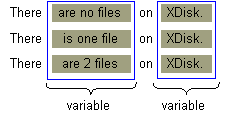Lesson: Formatting
Section: Messages
Java 教程是为 JDK 8 编写的。本页中描述的示例和实践未利用在后续版本中引入的改进。
处理复数
如果复数和单数形式都可能,则消息中的单词可能会有所不同。使用 ChoiceFormat 类,你可以将数字映射到单词或短语,从而允许你构造语法正确的消息。
在英语中,单词的复数和单数形式通常是不同的。当你构建引用数量的消息时,这可能会出现问题。例如,如果你的消息报告磁盘上的文件数,则可能存在以下变化:
There are no files on XDisk. There is one file on XDisk. There are 2 files on XDisk.
解决此问题的最快方法是创建一个 MessageFormat 模式,如下所示:
There are {0,number} file(s) on {1}.
不幸的是,前面的模式会导致错误的语法:
There are 1 file(s) on XDisk.
如果使用 ChoiceFormat 类,则可以做得更好。在本节中,你将通过逐步演示名为 ChoiceFormatDemo 的示例程序来学习处理消息中的复数形式。此程序还使用 MessageFormat 类,该类在上一节中讨论,Dealing with Compound Messages。
1. 定义消息模式
首先,确定消息中的变量:

接下来,使用参数替换消息中的变量,创建可应用于 MessageFormat 对象的模式:
There {0} on {1}.
磁盘名称的参数(由 {1} 表示)很容易处理。你只需将其视为 MessageFormat 模式中的任何其他 String 变量。此参数与参数值数组中索引 1 处的元素匹配。(见 step 7)。
处理参数 {0} 更复杂,原因如下:
- 此参数替换的短语因文件数而异。要在运行时构造此短语,你需要将文件数映射到特定的
String。例如,数字 1 将映射到包含短语is one file的String。ChoiceFormat类允许你执行必要的映射。 - 如果磁盘包含多个文件,则该短语包含整数。
MessageFormat类允许你在短语中插入数字。
2. 创建一个 ResourceBundle
因为必须翻译消息文本,所以将其隔离在 ResourceBundle 中:
ResourceBundle bundle = ResourceBundle.getBundle(
"ChoiceBundle", currentLocale);
示例程序使用属性文件支持 ResourceBundle。ChoiceBundle_en_US.properties 包含以下行:
pattern = There {0} on {1}.
noFiles = are no files
oneFile = is one file
multipleFiles = are {2} files
此属性文件的内容显示了如何构造和格式化消息。第一行包含 MessageFormat 的模式。(参见 step 1。)其他行包含将替换模式中的参数 {0} 的短语。multipleFiles 键的短语包含参数 {2},它将被一个数字替换。
以下是属性文件的法语版本,ChoiceBundle_fr_FR.properties
pattern = Il {0} sur {1}.
noFiles = n'y a pas de fichiers
oneFile = y a un fichier
multipleFiles = y a {2} fichiers
3. 创建消息格式化程序
在此步骤中,你将实例化 MessageFormat 并设置其 Locale:
MessageFormat messageForm = new MessageFormat("");
messageForm.setLocale(currentLocale);
4. 创建一个选择格式化程序
ChoiceFormat 对象允许你根据 double 编号选择特定的 String。double 数字的范围以及它们映射到的 String 对象在数组中指定:
double[] fileLimits = {0,1,2};
String [] fileStrings = {
bundle.getString("noFiles"),
bundle.getString("oneFile"),
bundle.getString("multipleFiles")
};
ChoiceFormat 将 double 数组中的每个元素映射到具有相同索引的 String 数组中的元素。在示例代码中,0 映射到通过调用 bundle.getString("noFiles") 返回的 String。巧合的是,索引与 fileLimits 数组中的值相同。如果代码已将 fileLimits[0] 设置为 7,则 ChoiceFormat 会将数字 7 映射到 fileStrings[0]。
在实例化 ChoiceFormat 时指定 double 和 String 数组:
ChoiceFormat choiceForm = new ChoiceFormat(fileLimits, fileStrings);
5. 应用模式
还记得你在第 1 步中构建的模式吗?是时候从 ResourceBundle 中获取模式并将其应用到 MessageFormat 对象:
String pattern = bundle.getString("pattern");
messageForm.applyPattern(pattern);
6. 指定格式
在此步骤中,为 MessageFormat 对象分配在步骤 4 中创建的 ChoiceFormat 对象:
Format[] formats = {choiceForm, null, NumberFormat.getInstance()};
messageForm.setFormats(formats);
setFormats 方法将 Format 对象分配给消息模式中的参数。在调用 setFormats 方法之前,必须调用 applyPattern 方法。下表显示了 Format 数组的元素如何与消息模式中的参数对应:
ChoiceFormatDemo 程序的 Format 数组
| 数组元素 | 模式参数 |
|---|---|
choiceForm |
{0} |
null |
{1} |
NumberFormat.getInstance() |
{2} |
7. 设置参数并格式化消息
在运行时,程序将变量分配给它传递给 MessageFormat 对象的参数数组。数组中的元素对应于模式中的参数。例如,messageArgument[1] 映射到模式参数 {1},它是包含磁盘名称的 String。在上一步中,程序将 ChoiceFormat 对象分配给模式的参数 {0}。因此,分配给 messageArgument[0] 的数字决定了 ChoiceFormat 对象选择的 String。如果 messageArgument[0] 大于或等于 2,则包含短语 are {2} files 的 String 将替换参数 {0}。分配给 messageArgument[2] 的编号将替换为模式参数 {2}。这是尝试这个的代码:
Object[] messageArguments = {null, "XDisk", null};
for (int numFiles = 0; numFiles < 4; numFiles++) {
messageArguments[0] = new Integer(numFiles);
messageArguments[2] = new Integer(numFiles);
String result = messageForm.format(messageArguments);
System.out.println(result);
}
8. 运行演示程序
将程序显示的消息与步骤 2 的 ResourceBundle 中的短语进行比较。请注意,ChoiceFormat 对象选择正确的短语,MessageFormat 对象用于构造正确的消息。ChoiceFormatDemo 程序的输出如下:
currentLocale = en_US There are no files on XDisk. There is one file on XDisk. There are 2 files on XDisk. There are 3 files on XDisk. currentLocale = fr_FR Il n'y a pas des fichiers sur XDisk. Il y a un fichier sur XDisk. Il y a 2 fichiers sur XDisk. Il y a 3 fichiers sur XDisk.